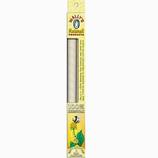Plain 100% Beeswax Ear Candles by Wally's Natural Products
12 Pack

Regular Retail: $38.69
Our low price: $28.34, 2 for
$55.19, 6 for
$155.23
All Products by
Wally's Natural Products
Item #: VBD020084
UPC: 609280300123
Description
Pure 100% beeswax ear candles is all natural, smell sweet with no oils, fragrances or additives. Ear Candles provide a safe and effective way to clear ear canals of wax build-up.
Ear Candling: The All Natural Process A traditional practice used for centuries, ear candling (also called coning) consists of placing a hollow cylinder coated with wax at the opening of the ear canal and lighting the other end to allow warm smoke to enter the ear.
Modern ear candling uses disposable hollow candles made from strips of unbleached cotton or linen dipped in paraffin or beeswax. The spiral roll of these candles creates the same effect as the ancient pottery ear cones. Some candles are made with herbs or essential oils mixed into the wax, in a similar way as the ancients placed herbs in their ear cones for the beneficial effects of the smoke.
Those who use ear candles claim the warm smoke that the candle delivers to the ear canal is soothing. They say the process is relaxing and often results in a sense of clarity after candling.
Though ear candlers originally thought the candle actually drew out earwax through suction, we now realize that this is not the case.
The Basics of Ear Candling An ear candle is gently placed in the outer ear canal, and the opposite end is ignited to produce a gentle, soft flow of warmth and smoke that flows into the ear. The candle is burned to about four inches from the ear, then cut, removed, and extinguished in a bowl of water.
The process is very soothing, relaxing and non-invasive, bringing spiritual energy and soothing herbal essences into the ear.
If the interior of the burned candle contains a brown powder, however, this could indicate there was not a good seal around the ear. Another candle should be used, making sure it fits properly, and listening for the crackling sound as the candle burns. At no point should the tip of the candle or the ear become hot to the touch. In fact, the candle should never burn down closer than 4 from the ear.
There should be no discomfort during the procedure or afterward. We suggest people allow a day or two between candling sessions.
If you have a serious ear disease, tubes in your ears, eardrum damage or an upper respiratory infection, consult a physician before you attempt this process.
Basic Rules Always have an assistant perform the process. Use fresh supplies and work in a clean area. Use common sense around fire. Do not insert sharp objects or push anything into the ears. If anything falls into the ear, stop the procedure and tilt the head to let the material fall out. You can also flush clean water into the ear to rinse out any of this material. Following these suggestions will help prevent any injury or harm to the ear. Procedure - Use damp towels or Wally's Head & Shoulder Cover to cover the hair, face and clothing.
- The person should sit up (as shown above) during the process.
- Use aluminum pie pan with hole for candle, angling the candle about 10 degrees upward.
- Light candle, and let smoke and warmth soothe the ear.
- As candle burns, cut off the ash into a bowl of water.
- During the procedure, you may massage the face in the areas of the sinuses (around the cheek, nose and eye) and along the side of the person's neck.
- When candle burns to about 4 in length, carefully remove it from the ear and extinguish the candle in the bowl of water.
Supplies Wally's Ear Candles (2-4 per ear) Scissors Small bowl of water Aluminum pie pan (with a hole cut off-center for the candle to fit through) Matches or lighter to light ear candles Dampened towels or fire retardant covers (to cover the head and upper body and protect hair, clothing, bedding and furniture). Wally's Ear Oil to sooth
Note:
Product image may vary in look, size, quantity and/or flavor. It should only be used as a reference. Please check with the manufacturer for the most up-to-date product information.
Although we try very hard to keep the product information up-to-date, occasionally, the manufacturer changes the name and the packaging of a product without notice.

 Regular Retail: $38.69
Regular Retail: $38.69